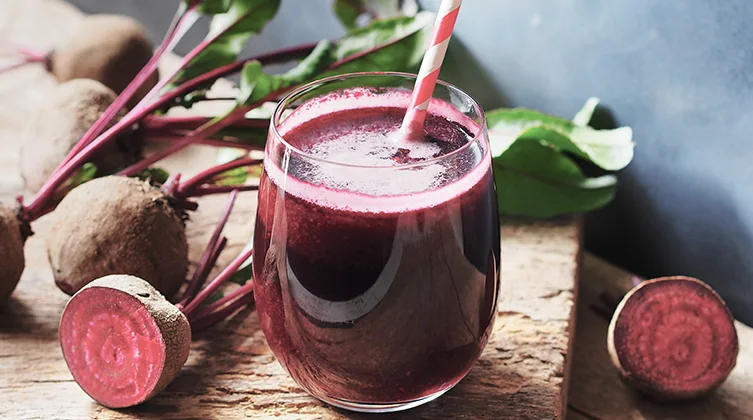The sports supplements market is a booming industry propagated by hyperbolic marketing hype. To cut through the noise, below is an informative (no affiliated or commercially-invested) list of some of the best sports supplements, also known as ergogenic aids, that are supported by science.
1) Beetroot juice
I first noticed the appearance of beetroot juice during one of my curious expeditions around Chemist Warehouse (everyone does that right?). At the time, it struck me as bizarre, until it resurfaced in great detail during my sports nutrition studies. Beetroot juice has emerged as one of the most novel and growing areas of sports nutrition research. It is suggested that beetroot juice can improve stamina by reducing the oxygen cost of exercise, increasing blood flow and lowering blood pressure.
The physiological mechanisms underpinning how beetroot juice works are quite complex but also extremely fascinating! Beetroot juice is one of the most potent sources of nitrate. In the body, nitrate is converted to nitric oxide (NO); a process, which actually occurs in the mouth by resident bacteria (1)! It is through the powerful actions of NO that beetroot juice accomplishes its performance enhancing activities.
So why not just consume NO? NO is actually a gas, making it physically inconvenient to contain and consume in a sporting or home environment. Also, beetroot juice delivers NO via an effective and safe vehicle.
The standard types of beetroot juice sports supplements found on the market include concentrated 70mL “shots” that deliver around 400 mg of nitrate (e.g. Beet It) or less concentrated beetroot juices. Beetroot juice can also be made at home by juicing whole beets; however the nitrate content is more variable and less certain.
Potential side-effects: Temporary pink colouration of urine and stools.
2) Caffeine
Caffeine is arguably the world’s most socially acceptable drug. Its performance enhancing effects are related to the stimulation of adrenaline, which increases the recruitment of muscle fibres and reduces the perception of effort or fatigue (i.e. exercise “feels” easier). Previously it was believed that caffeine enhanced fat utilisation during exercise. However, this is now considered an unlikely mechanism to explain caffeine’s overall performance effects. As for caffeine and dehydration, such claims often over-stated, especially in habitual caffeine consumers.
Dietary sources of caffeine provide a highly variable amount ranging from 30-120 mg (2); while supplements, such as No-Doz, provide a more reliable dose of 100 mg per tablet (3). Scientific studies show that approximately 1-3 mg/kg of caffeine is effective to enhance performance in events lasting 1 hour or longer and that dosages beyond this amount offer no additional benefits.
Potential side-effects: Over-arousal, irritability, increased heart rate, impaired fine motor control, sleep disturbances and gastrointestinal upsets.
3) Bicarbonate
When we exercise intensely, our working muscles produce lactate and hydrogen ions (acid). A build-up of these hydrogen ions can lead to acidification and contribute to fatigue. Bicarbonate, which the body produces naturally, is alkaline and helps to neutralise the hydrogen ions by acting as a buffer. By consuming additional bicarbonate, it is believed that the intensity of exercise can be maintained for longer before excess hydrogen ions build-up and lead to fatigue. The greatest effects of bicarbonate supplementation on performance have been seen in events lasting 1-7 minutes of high intensity.
Potential side-effects: Some people can experience gastrointestinal problems. Splitting the dosage over several days can help overcome these adverse side-effects.
4) Creatine
Creatine is naturally present in the body’s skeletal muscle and acts as an immediate fuel source when rapid, quick bursts of exercise occur (e.g. a 5-10 second sprint). It also acts as a hydrogen ion buffer and assists with the creation of ATP (the currency of energy used by all the cells in the body). By enhancing creatine stores through supplementation, it is believed that fatigue can be reduced and intensity enhanced during bouts of repeated high-intensity activities with short rest intervals in between. Examples include intermittent sports (e.g. team games), interval training and resistance training.
Potential side-effects: Creatine attracts water, which can result in some swelling and weight gain. Also, some studies have shown a ‘non-responder’ effect. That is, some individuals show very little performance enhancement with creatine supplementation.
5) Whey protein
Protein supplementation is extremely popular among elite athletes and recreational exercisers alike. This is mostly due to the role of amino acids (the building blocks of proteins) in muscle growth and repair, and therefore, enhancing recovery, strength- and hypertrophy-related adaptations.
There is a never ending assortment of protein powders and protein supplements saturating the supplement market. The most common protein derivatives include whey, casein or milk, soy and egg albumin. Some studies suggest that only the essential amino acids (EAAs) are necessary to stimulate maximal muscle protein synthesis (a process called anabolism; MPS) with the branched chain amino acid, leucine, playing an essential role in “triggering” this process. EAAs are those which the body cannot produce endogenously but must be supplied in the diet (including leucine).
Maximal MPS is stimulated with the consumption of 20-25 g of protein. This corresponds to about 8.5g EAAs or 1.5g leucine (4). Beyond this amount, additional benefits are essentially negligible and indeed may be detrimental. The body is constantly underdoing a process of protein synthesis and degradation. However, the greatest gains in MPS are seen when protein supplements are consumed post-exercise, called the ‘window of opportunity’. Evidence for the pre- and during exercise periods require further research.
Potential side-effects: Sports supplements are not subjected to same rigorous regulation as the pharmaceutical industry. Therefore, a greater potential risk of contamination with prohibited substances exists, which could result in a positive drug test. Indeed, one landmark international study found that 15% of sports supplements were contaminated and that 68% of the contaminants were banned pro-hormones.
6) Sports gels
Sports gels are highly concentrated sources of carbohydrates (source of energy) that are easy to consume and quick to digest. Sometimes they can contain additional ingredients, such as caffeine. Many newer gels include multiple transportable carbohydrates – that is, a blend of different carbohydrates (glucose, fructose and their derivatives) that use different transport molecules for absorption across the intestinal walls. The purpose of these mixtures is to enhance the uptake of carbohydrates.
Sports gels are usually consumed prior to and during long-duration activity. Carbohydrates provided during activity can help maintain blood glucose levels, ensure a continuous supply of energy to the working muscles, spare the catabolism (breakdown) of protein, delay fatigue and improve performance. Carbohydrate ingestion may also attenuate a rise in stress hormones, such as cortisol, and improve post-exercise recovery.
Potential side-effects: Potential gastrointestinal discomfort with excess fructose consumption, especially for individuals with fructose malabsorption. Fructose should not be provided as the sole source of carbohydrate.
7) Probiotics
Probiotics are live bacteria that confer a range of desirable benefits to the host (e.g. humans), including greater immune support. Several scientific studies conducted since 2006 evaluating the efficacy of probiotics in athletes or highly active people have found modest benefits in improving the frequency and duration of respiratory infections and gastrointestinal issues (6). This is of particular importance for individuals who exercise frequently and intensely, as they are usually at greater risk of developing upper respiratory tract infections and gastrointestinal disturbances (6).
Probiotic sources are available commercially in capsule form or as powders, as well as in select foods, such as yoghurt, fermented vegetables, sauerkraut, kimchee, tempeh and miso.
Potential side-effects: Probiotics are generally safe. Side-effects, if they occur, may include mild gas and bloating.
Note:
This article was designed for leisurely reading and information purposes only. The incorporation of any novel supplements into the diet should be considered on an individual basis and with the assistance of a qualified nutritionist or dietitian to ensure the most appropriate strategy and best results are achieved.





